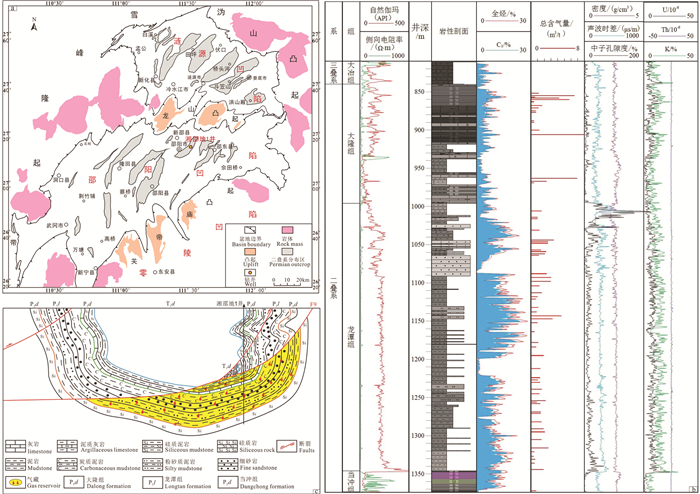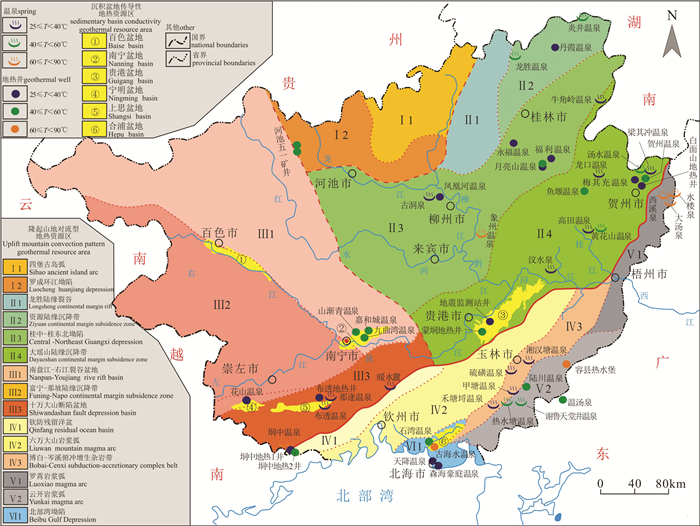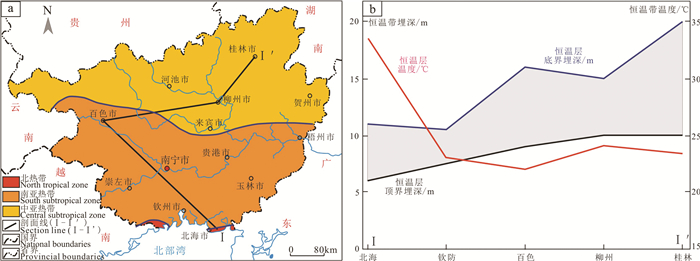-
摘要:研究目的
广西地热资源分布广泛,是一种极具竞争力的低碳可再生清洁能源。目前,针对广西地热资源赋存规律、分布特征和资源潜力的系统性研究相对薄弱,在一定程度上制约了广西地热资源的综合性开发和利用。
研究方法本文基于“十二五”以来广西浅层地温、水热型和干热型地热资源调查评价最新成果,对广西壳幔圈层结构、现今地温场特征和地热资源分布规律进行系统性分析;采用不同的资源量估算方法,分别对浅层地热能资源、水热型地热资源和干热型地热资源的开发利用潜力进行评价。
研究结果研究表明,广西地热资源丰富,发育明显的赋存规律和分区分带性特征。其中,广西浅层地热能资源和水热型地热资源均以直接利用为主要开发方式,13个主要城市浅层地热能资源总热容量为1.23×1015 kJ/℃,年可开采利用资源量为1.36×1012 kJ/a,折合标准煤1.67×108 t;广西现有温(热)泉出露点24处,地热开采井28口,地热能资源总量为2.56×1017 kJ,折合标准煤87.58×108 t;地热流体年可采热量为28.89×1012 kJ/a,折合标准煤315.65×104 t。广西干热型地热资源量潜力巨大,陆域3~10 km范围内干热岩资源总量为55.42×104 EJ,折合标准煤18.91×1012 t,按2%的可采率计算是中国2020年一次能源消耗总量(49.8亿t)的75.94倍,是最理想的传统化石能源的接替载体。
结论广西在传统能源领域“缺煤、少油、乏气”,但在新能源领域具有“风大、水足、热持久”的优势,对地热资源的合理开发利用将有助于广西能源结构的优化和产业结构的战略性调整,助力于中国“双碳”目标的达成。
创新点:1)首次系统性梳理了“十二五”以来广西地热资源调查评价的最新成果,对广西地热资源赋存规律和分布特征进行系统性研究;2)采用不同的资源量估算方法,对广西浅层地热、水热型和干热型地热资源的开发利用潜力进行综合性评价,为广西地热资源的总体规划和综合开发奠定了基础。
Abstract:This paper is the result of geothermal resources survey engineering.
ObjectiveIn Guangxi, the geothermal resource is extensively distributed, and is a competitive low-carbon, renewable and clean energy. Up to now, the systematic research on the occurrence regulation, distribution characteristics and potential of geothermal resources is relatively weak, to a certain extent, which restricts the comprehensive development and utilization in Guangxi.
MethodsIn this paper, we systematically analyzed the structure of the crust and mantle layer, the present characteristics of the geothermal field and the distribution pattern of geothermal resources, based on the latest results of the survey and evaluation of shallow geothermal, hydrothermal and hot dry rock geothermal resources in Guangxi since the "Twelfth Five-Year Plan". And we chose different methods to evaluate the development and utilization potential of shallow geothermal energy resources, hydrothermal geothermal resources and hot dry rock geothermal resources.
ResultsThe research shows that the geothermal resources are rich in Guangxi, with obvious occurrence rules and zoning characteristics. In 13 major cities, the shallow and hydrothermal geothermal resources are mainly developed through direct utilization, and the shallow geothermal resources are 1.23×1015 kJ/℃, the annual exploitable resources are 1.36×1012 kJ/a, equivalent to 1.67×108 t standard coal. And 24 warm(hot) springs points and 28 geothermal mining wells locating in Guangxi, the total amount of geothermal energy resources is 2.56×1017 kJ, which is equivalent to 87.58×108 t of standard coal. On the other hand, the annual recoverable heat of geothermal fluid is 28.89×1012 kJ/a, which is equivalent to 315.65×104 t of standard coal. Finally, the potential of dry hot geothermal resources is great in Guangxi, within 3-10 km of the land area, the total amount of hot dry rock resources is 55.42×104 EJ, which is equivalent to 18.91×1012 t of standard coal, at a recoverable rate of 2% which is 75.94 times the 2020 Chinese primary energy consumption(4.98 billion tons). Therefore, it is becoming the most ideal replacement carrier for traditional fossil energy.
ConclusionsGuangxi is lack of coal, oil and gas in the traditional energy field, and has rich wind, water and heat in the new energy field. The rational development and utilization of geothermal resources will contribute to the optimization of energy structure and the strategic adjustment of industrial structure in Guangxi, and help to achieve the "dual carbon goal".
-
1. 研究目的(Objective)
湘中坳陷作为南方复杂构造区页岩气勘探的热点地区之一,也是中国油气勘探久攻未克的地区。前期在湘中地区北部的涟源凹陷泥盆系和石炭系获得了页岩气突破和发现,证实了湘中地区上古生界页岩气资源丰富。但对湘中地区南部的邵阳凹陷调查程度较为薄弱,针对邵阳凹陷二叠系仅开展了少量基础地质调查工作,页岩气资源潜力评价方面的工作尤为欠缺。本次研究依托邵阳湘邵地1井(XSD1井)钻探工程建立了邵阳凹陷二叠系地层层序序列,揭示了主要含气页岩层系的分布特征,获取了含气性评价参数,对湘中地区二叠系页岩气勘探开发和重新评价湘中坳陷页岩气资源潜力具有重要的现实意义。
2. 研究方法(Methods)
中国地质调查局武汉地质调查中心在收集分析区域地质相关资料的基础上,结合邵阳凹陷短陂桥向斜的煤田浅钻、非震物探等资料开展页岩气地质综合评价,采用页岩埋深500~4500 m,页岩有机碳含量≥1.0%,页岩厚度≥15 m,页岩有机质热演化程度1.0%~3.5%的评价参数在短陂桥向斜区优选页岩气远景区,论证部署了1口小口径页岩气地质调查井—XSD1井,湖南煤田地质勘查有限公司组织实施钻探(图 1a)。该井采样全井段取心钻井工艺,测井选取PSJ-2数字测井系统,录井采用SK-2000G气测录井,钻获二叠系大隆组156.05 m(暗色硅质页岩、钙质泥岩94.48 m),龙潭组349.95 m(暗色泥岩216.93 m,粉砂质泥岩36.9 m),对这两套层系共采集暗色泥岩样品33件,进行解析气含量测定分析,落实了含气性评价参数。
3. 结果(Results)
本次样品分析工作由武汉地质调查中心古生物与生命-环境协同演化重点实验室完成,采用YSQ-IIIA岩石解析气测定仪(燃烧法)对含气段岩心共计33件样品进行分析。该井钻获二叠系大隆组厚度156.05 m,为一套硅质岩、硅质页岩、炭质钙质泥岩地层。其中在井深842~930.2 m硅质页岩、钙质泥岩段,气测全烃值从1.06%上升至16.54%,甲烷值从1.01%上升至14.04%,13件大隆组硅质页岩现场解析总含气量为1.29~9.97 m3/t,平均4.85 m3/t。实现了湘中坳陷二叠系页岩气新发现,有效拓展了华南地区大隆组勘探范围。
钻获龙潭组厚度349.95 m,上段为一套细砂岩、粉砂岩夹泥岩潮坪相沉积地层,下段为一套炭质泥岩、粉砂质泥岩夹薄层细砂岩泻湖相沉积地层。在井深1013.4~1048 m泥岩与粉砂岩互层段气测全烃值最高可达19.87%,甲烷值最高为16.94%,7件泥岩与粉砂岩样品现场解析总含气量0.57~3.42 m3/t,平均1.78 m3/t;井深1088.10~1199.75 m泥岩夹泥质粉砂岩含气层111.6 m,气测全烃值最高可达28.2%,甲烷值最高为23.6%,13件泥岩、粉砂质泥岩样品现场解析总含气量0.90~4.55 m3/t,平均2.01 m3/t(图 1b),首次查明了湘中坳陷二叠系龙潭组非常规油气分布特点。
通过区域地质背景分析,并结合煤田区域地质资料,本研究认为滑脱断裂(F9)上下盘具有不同的页岩气聚集条件。滑脱断裂之上由一系列的同向逆断层形成的逆冲推覆体,地层变形强烈,且裂缝发育,导致页岩气保存条件变差。滑脱断裂下盘是页岩气主要富集区,地层平缓,不发育次级通天断裂,与下盘地层形成反向遮挡,易形成封闭,保存条件良好(图 1c)。
4. 结论(Conclusions)
(1)二叠系大隆组岩性以硅质岩、硅质页岩为主,夹少量灰岩。主要含气段存在于上段硅质页岩段,厚88.2 m,含气量平均为4.85 m3/t,含气性优越,资源潜力大。
(2)二叠系龙潭组上段以致密砂岩气为主,含气量平均为1.78 m3/t;下段以页岩气为主,泥岩厚达177.47 m,含气量平均为2.01 m3/t,具有泥岩厚度大,含气性好等特征。
(3)保存条件是页岩气富集关键,构造改造弱的封闭演化环境有利于页岩气保存,研究区滑脱断裂下盘是页岩气主要富集区,易形成封闭,保存条件良好。
(4)湘邵地1井在二叠系大隆组和龙潭组获得良好的页岩气显示,证实了湘中地区二叠系具有良好的页岩气资源潜力,对湘中地区页岩气资源潜力评价具有重要意义。
5. 基金项目(Fund support)
本文为中国地质调查局项目“中扬子地区油气页岩气调查评价”(DD20221659)资助的成果。
-
表 1 广西典型中深孔地温监测统计(据康志强等,2020修编)
Table 1 Statistical table of ground temperature monitoring in typical in middle and deep holes in Guangxi(modified from Kang Zhiqiang et al., 2020)

表 2 广西13个主要城市浅层地热能热容量、换热功率计算汇总
Table 2 Summary of the calculation of heat capacity and heat transfer rate of shallow geothermal resources in 13 major cities in Guangxi

表 3 广西主要隆起山地型地热资源评价
Table 3 Evaluation of geothermal resources of main uplifted mountains in Guangxi

表 4 广西主要沉积盆地型地热资源评价
Table 4 Evaluation of geothermal resources of main sedimentary basins in Guangxi

表 5 广西陆域3~10 km干热型地热资源评价
Table 5 Evaluation of hot dry rock geothermal resources at the depth of 3-10 km in Guangxi's land area

-
Bronicki L Y. 2016. Geothermal Power Generation-Introduction to Geothermal Power Generation[M]. Woodhead Publishing: 1-3.
Climate Center of Guangxi. 2021. Guangxi 2020 Climate Bulletin [EB/OL]. http://gx.cma.gov.cn/qxfw/qxgb/202105/t20210527_3356241.html(in Chinese).
Duchance D V. 1996. Geothermal energy from hot dry rock: A renewable energy technology moving towards practical implementation[J]. Renewable Energy, 9(1/4): 1246-1249.
Guangxi Institute of Geological Survey. 2015a. Investigation, Evaluation and Regionalization of Geothermal Resources in Guangxi[R]. Nanning: Guangxi Institute of Geological Survey(in Chinese).
Guangxi Institute of Geological Survey. 2015b. Hydrogeological Survey Report (1: 50000) of Shallow Geothermal Energy Development Zones in Major Cities in Guangxi[R]. Nanning: Guangxi Institute of Geological Survey (in Chinese).
Guangxi Regional Geological Survey Research Institute. 2017. Regional Geology of Guangxi[R]. Guilin: Regional Geological Survey Research Institute (in Chinese with English abstract).
Huttrer G W. 2020. Geothermal power generation in the world 2015-2020 update report[C]//Proceedings World Geothermal Congress 2020. Reykjavik: WGC.
Kang Zhiqiang, Zhang Qizuan, Guan Yanwu, Feng Bo, Yuan Jinfu, Sun Minghang, Liu Demin, Wang Xinyu, Yang Zhiqiang, Lu Jipu, Zhang Qinjun, Feng Minhao. 2020. Evaluation of thermal conditions and potential of dry hot rock resources in Hepu Basin, Guangxi[J]. Journal of Jilin University(Earth Science Edition), 50(4): 1151-1160 (in Chinese with English abstract).
Li Sanzhong, Cao Xianzhi, Wang Guangzeng, Liu Bo, Li Xiyao, Suo Yanhui, Jiang Zhaoxia, Guo Lingli, Zhou Jie, Wang Pengcheng, Zhu Junjiang, Wang Gang, Zhao Shujuan, Liu Yongjiang, Zhang Guowei. 2019. Meso-Cenozoic tectonic evolution and plate reconstruction of the Pacific Plate[J]. Journal of Geomechanics, 25(5): 642-677 (in Chinese with English abstract).
Lin Wenjing, Liu Zhiming, Ma Feng, Liu Chunlei, Wang Guiling. 2012. An estimation of HDR resources in China's Mainland[J]. Acta Geoscientica Sinica, 33(5): 807-811(in Chinese with English abstract).
Lin Wenjing, Liu Zhiming, Wang Wanli, Wang Guiling. 2013. The assessment of geothermal resources potential of China[J]. Geology in China, 40(1): 312-321(in Chinese with English abstract).
Lund J W, Boyd T L. 2016. Direct utilization of geothermal energy 2015 worldwide review[J]. Geothermics, 60: 66-93. doi: 10.1016/j.geothermics.2015.11.004
Ma Bing, Jia Lingxiao, Yu Yang, Wang Huan, Chen Jing, Zhong Shuai, Zhu Jichang. 2021. Geoscience and carbon Neutralization: Current status and development direction[J]. Geology in China, 48(2): 347-358 (in Chinese with English abstract).
Mao Xiang, Guo Dianbin, Luo Lu, Wang Tinghao. 2019. The global development process of hot dry rock (enhanced geothermal system) and its geological background[J]. Geological Review, 65(6): 1462-1472 (in Chinese with English abstract).
Muffler L J P. 1976. Tectonic and Hydrologic Control of the nature and Distribution of Geothermal Resources[R]. Process Second U. N. Symposium on the Development and Use of Geothermal Resources. San Francisco, 499-507.
Our World in Data. 2021a. Installed geothermal energy capacity [EB/OL]. https://ourworldindata.org/energy-mix.
Our World in Data. 2021b. Installed geothermal energy capacity [EB/OL]. https://ourworldindata.org/search?q=Geothermal.
Peng Songbai, Liu Songfeng, Lin Musen, Wu Changfeng, Han Qingsen. 2016. Early Paleozoic subduction in Cathaysia (Ⅱ): New evidence from the Dashuang high magnesian-magnesian andesite[J]. Earth Science, 41(6): 931-947 (in Chinese with English abstract).
Song Bo, Yan Quanren, Xiang Zhongjin, Chen Huiming, Ma Tieqiu, Yang Guangyuan. 2013. Sedimentary characteristics and tectonic setting of the Middle Triassic Pingxiang basin, Guangxi[J]. Acta Geologica Sinica, 87(4): 453-473(in Chinese with English abstract).
Sun Minghang, Liu Demin, Kang Zhiqiang, Guan Yanwu, Liang Guoke, Huang Xiqiang, Ye Jiahui, Guo Shangyu, Sun Xingting, Tang Weri, Feng Minhao. 2020. Analysis of hot-dry geothermal resource potential in southeastern Guangxi[J]. Earth Science Frontiers, 27(1): 72-80 (in Chinese with English abstract).
Sun Minghang, Wang Ruihu, Guan Yanwu, Liu Demin. 2022a. An estimate of hot-dry geothermal resources in the continental area, Guangxi[J]. Journal of Jilin University (Earth Science Edition), 97(4): 454-474 (in Chinese with English abstract).
Sun Minghang, Zhang Qizuan, Liu Demin, Sun Xingting, Lin Shan, Wu Xiangke, Liang Guoke, Guan Yanwu, Ye Jiahui, Li Yefei. 2022b. Research on the genesis and occurrence models of Hot-Dry geothermal resources in Guangxi[J]. Bulletin of Geological Science and Technology, 40(3): 1-11 (in Chinese with English abstract).
Tang Xianchun, Wang Guiling, Ma Yan, Zhang Dailei, Liu Zhong, Zhao Xu, Cheng Tianjun. 2020. Geological model of heat source and accumulation for geothermal anomalies in the Gonghe basin, northeastern Tibetan Plateau [J]. Acta Geologica Sinica, 94(7): 2052-2065 (in Chinese with English abstract).
Wang Denghong, Chen Yuchuan, Jiang Biao, Huang Fan, Wang Yan, Li Huaqin, Hou Kejun. 2020. Preliminary study on the Triassic continental mineralization system in China[J]. Earth Science Frontiers, 27(2): 45-59 (in Chinese with English abstract).
Wang Guiling, Zhang Wei, Liang Jiyun, Lin Wenjing, Liu Zhiming, Wang Wanli. 2017. Evaluation of geothermal resources potential in China[J]. Acta Geoscientica Sinica, 38(4): 449-450, 134, 451-459(in Chinese with English abstract).
Wang Guiling, Zhang Wei, Ma Feng, Lin Wenjing, Liang Jiyun, Zhu Xi. 2018. Overview on hydrothermal and hot dry rock researches in China[J]. China Geology, 1: 273-285. doi: 10.31035/cg2018021
Wang Jiyang, Hu Shengbiao, Pang Zhonghe, He Lijuan, Zhao Ping, Zhu Chuanqing, Rao Song, Tang Xiaoyin, Kong Yanlong, Luo Lu, Li Weiwei. 2012. Estimate of geothermal resources potential for Hot Dry Rock in the continental area of China[J]. Science & Technology Review, 30(32): 25-31(in Chinese with English abstract).
Wang Jiyang. 2015. Geothermics and Its Applications[M]. Beijing: Science Press (in Chinese with English abstract).
Wang Jun, Huang Shangyao, Huang Geshan, Wang Jiyang. 1990. The Basic Characteristics of Chinese Geothermal Distribution[M]. Beijing: Seismological Press (in Chinese with English abstract).
Wang Qianshen, Teng Jiwen, Zhang Yongqian, Chen Shi, Wen Wu, Pi Jiaolong, Ma Xueying. 2017. Discussion on the crustal density distribution and deep crustal structure of the super-long profile from Mandula (Inner Mongolia) to Pingxiang (Guangxi) [J]. Chinese Journal of Geophysics, 60(12): 4681-4698 (in Chinese with English abstract).
West F G, Shankland T J. 2013. Hot dry rock: Widespread but invisible[J]. Eos Transactions American Geophysical Union, 58(5): 299-302.
White D E, Williams D L. 1975. Assessment of Geothermal Resources of the United States[R]. Arlington, Virginia, US: US Geological Survey.
Xiong Liangping, Gao Weian. 1982. Characteristics of geotherm in uplift and depression[J]. Acta Geophysica Sinica, (5): 448-456 (in Chinese with English abstract).
Xu Xiaosong, Liu Wei, Men Yupeng, Zhang Haiquan. 2012. Probe into the tectonic nature of Neoproterozoic southern Hunan-northern Guangxi marine basin[J]. Acta Geologica Sinica, 86(12): 1890-1904 (in Chinese with English abstract).
Ye Songqing, Li Shouyi. 2011. Mineral Exploration (3nd ed) [M]. Beijing: Geological Publishing House(in Chinese).
Yuan Yusong, Ma Yongsheng, Hu Shengbiao, Guo Tonglou, Fu Xiaoyun. 2006. Prensent-day geothermal characteristics in South China[J]. Chinese Journal of Geophysics, 49(4): 1118-1126 (in Chinese with English abstract).
Zhao Jianbin, Feng Xiaoyan, Yan Keqi, Guo Hui. 2011. The key technical analysis on the hot dry rock in northeast cold in China[J]. Applied Mechanics & Materials, 71-78: 1268-1272.
广西壮族自治区地质调查院. 2015a. 广西壮族自治区地热资源调查评价与区划报告[R]. 广西壮族自治区地质调查院. 2015b. 广西主要城市浅层地温能开发区1: 5万水文地质调查报告[R]. 广西壮族自治区气候中心. 2021. 广西2020年气候公报[EB/OL]. http://gx.cma.gov.cn/qxfw/qxgb/202105/t20210527_3356241.html. 广西壮族自治区区域地质调查研究院. 2017. 广西壮族自治区区域地质志[R]. 康志强, 张起钻, 管彦武, 冯波, 袁金福, 孙明行, 刘德民, 王新宇, 杨志强, 陆济璞, 张勤军, 冯民豪. 2020. 广西合浦盆地干热岩资源成热条件及潜力评价[J]. 吉林大学学报(地球科学版), 50(4): 1151-1160. https://www.cnki.com.cn/Article/CJFDTOTAL-CCDZ202004019.htm 李三忠, 曹现志, 王光增, 刘博, 李玺瑶, 索艳慧, 姜兆霞, 郭玲莉, 周洁, 王鹏程, 朱俊江, 汪刚, 赵淑娟, 刘永江, 张国伟. 2019. 太平洋板块中-新生代构造演化及板块重建[J]. 地质力学学报, 25(5): 642-677. https://www.cnki.com.cn/Article/CJFDTOTAL-DZLX201905005.htm 蔺文静, 刘志明, 马峰, 刘春雷, 王贵玲. 2012. 我国陆区干热岩资源潜力估算[J]. 地球学报, 33(5): 807-811. https://www.cnki.com.cn/Article/CJFDTOTAL-DQXB201205018.htm 蔺文静, 刘志明, 王婉丽, 王贵玲. 2013. 中国地热资源及其潜力评估[J]. 中国地质, 40(1): 312-321. http://geochina.cgs.gov.cn/geochina/article/abstract/20130121?st=search 马冰, 贾凌霄, 于洋, 王欢, 陈静, 钟帅, 朱吉昌. 2021. 地球科学与碳中和: 现状与发展方向[J]. 中国地质, 48(2): 347-358. http://geochina.cgs.gov.cn/geochina/article/abstract/20210201?st=search 毛翔, 国殿斌, 罗璐, 王婷灏. 2019. 世界干热岩地热资源开发进展与地质背景分析[J]. 地质论评, 65(6): 1462-1472. https://www.cnki.com.cn/Article/CJFDTOTAL-DZLP201906018.htm 彭松柏, 刘松峰, 林木森, 吴长峰, 韩庆森. 2016. 华夏早古生代俯冲作用(Ⅱ): 大爽高镁-镁质安山岩新证据[J]. 地球科学, 41(6): 931-947. https://www.cnki.com.cn/Article/CJFDTOTAL-DQKX201606003.htm 宋博, 闫全人, 向忠金, 陈辉明, 马铁球, 杨广元. 2013. 广西凭祥中三叠世盆地沉积特征与构造属性分析[J]. 地质学报, 87(4): 453-473. https://www.cnki.com.cn/Article/CJFDTOTAL-DZXE201304003.htm 孙明行, 刘德民, 康志强, 管彦武, 梁国科, 黄锡强, 叶家辉, 郭尚宇, 孙兴庭, 唐维, 冯民豪. 2020. 桂东南地区干热型地热资源潜力分析[J]. 地学前缘, 27(1): 72-80. https://www.cnki.com.cn/Article/CJFDTOTAL-DXQY202001010.htm 孙明行, 王瑞湖, 管彦武, 刘德民. 2022a. 广西陆域干热型地热资源潜力估算[J]. 吉林大学学报(地球科学版), 97(4): 454-474. https://www.cnki.com.cn/Article/CJFDTOTAL-CCDZ202204020.htm 孙明行, 张起钻, 刘德民, 孙兴庭, 林珊, 吴祥珂, 梁国科, 管彦武, 叶家辉, 李叶飞. 2022b. 广西干热型地热资源成因机制与赋存模式研究[J]. 地质科技通报, 40(3): 1-11. https://www.cnki.com.cn/Article/CJFDTOTAL-DZKQ202203035.htm 唐显春, 王贵玲, 马岩, 张代磊, 刘忠, 赵旭, 程天君. 2020. 青海共和盆地地热资源热源机制与聚热模式[J]. 地质学报, 94(7): 2052-2065. https://www.cnki.com.cn/Article/CJFDTOTAL-DZXE202007013.htm 汪集暘, 胡圣标, 庞忠和, 何丽娟, 赵平, 朱传庆, 饶松, 唐晓音, 孔彦龙, 罗璐, 李卫卫. 2012. 中国大陆干热岩地热资源潜力评估[J]. 科技导报, 30(32): 25-31. https://www.cnki.com.cn/Article/CJFDTOTAL-KJDB201232017.htm 汪集暘. 2015. 地热学及其应用[M]. 北京: 科学出版社. 王登红, 陈毓川, 江彪, 黄凡, 王岩, 李华芹, 侯可军. 2020. 中国三叠纪大陆成矿体系[J]. 地学前缘, 27(2): 45-59. https://www.cnki.com.cn/Article/CJFDTOTAL-DXQY202002005.htm 王贵玲, 张薇, 梁继运, 蔺文静, 刘志明, 王婉丽. 2017. 中国地热资源潜力评价[J]. 地球学报, 38(4): 449-450, 134, 451-459. https://www.cnki.com.cn/Article/CJFDTOTAL-DQXB201704002.htm 王均, 黄尚瑶, 黄歌山, 汪集旸. 1990. 中国地温分布的基本特征[M]. 北京: 地震出版社. 王谦身, 滕吉文, 张永谦, 陈石, 文武, 皮娇龙, 马学英. 2017. 内蒙满都拉-广西凭祥超长剖面地壳介质密度分布及深部结构特征探榷[J]. 地球物理学报, 60(12): 4681-4698. https://www.cnki.com.cn/Article/CJFDTOTAL-DQWX201712012.htm 熊亮萍, 高维安. 1982. 隆起与拗陷地区地温场的特点[J]. 地球物理学报, (5): 448-456. https://www.cnki.com.cn/Article/CJFDTOTAL-DQWX198205008.htm 许效松, 刘伟, 门玉澎, 张海全. 2012. 对新元古代湘桂海盆及邻区构造属性的探讨[J]. 地质学报, 86(12): 1890-1904. https://www.cnki.com.cn/Article/CJFDTOTAL-DZXE201212004.htm 叶松青, 李守义. 2011. 矿产勘查学(3版) [M]. 北京: 地质出版社. 袁玉松, 马永生, 胡圣标, 郭彤楼, 付孝悦. 2006. 中国南方现今地热特征[J]. 地球物理学报, 49(4): 1118-1126. https://www.cnki.com.cn/Article/CJFDTOTAL-DQWX200604024.htm




 下载:
下载:


